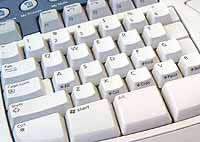In today’s world, understanding all the facets of modern technology can be extremely difficult. The technical jargon and many acronyms can make technology seem awfully cryptic.
To many, computer literacy is one of the biggest technological hurdles they will face. As computers become more and more common, understanding them has become very critical. Learning computer basics, however, doesn’t always have to be so difficult.
One of the most important facets of computer literacy is the use of hot keys (keyboard commands). Hot keys are simply key combinations that invoke particular operations when pressed, and are often denoted with a plus sign (+). Most hot keys are used in conjunction with a modifier key, like Control (CTRL), Shift (SHIFT) or Alternate (ALT). For example, the hot key CTRL+S means to press the control and S keys simultaneously.
Most program features can be accessed graphically (via mouse) or with a hot key (via keyboard). Although many feel intimidated by the keyboard, pressing a hot key is often faster and more efficient than locating the item graphically with the mouse. Being proficient with the mouse and keyboard will help you complete work easier and do it in less time.
Finding what hot keys a program uses is fairly simple. Most hot keys are displayed to the right of each command under the appropriate drop-down text menu (menus located toward the top of the program, like “file,” “edit,” “window” and so on).
Some programs list all of their hot keys in the program’s help guide. In many programs, pressing F1 will open the help system. Help can also be found under the textual “help” menu (toward the top of the screen).
Not all programs use the same hot keys to invoke the same operations. There are a number of hot keys, however, that are extremely common among most PC programs. Here are a few:
• CTRL+N (New) – Creates a new, blank document. Pressing CTRL+N is the same as selecting “new” from the “file” menu.
• CTRL+O (Open) – Open a document for viewing or editing. Pressing CTRL+O is the same as selecting “open” from the “file” menu, and will invoke a box that allows you to select the file you want to open.
• CTRL+S (Save) – Saves any unsaved changes made to the currently open document (the document you’re working on). If the file hasn’t been given a name yet (a new untitled document, for example), you will be asked to give the document a name (and select a location for the saved file) before it can be properly saved.
• CTRL+SHIFT+S or F12 (Save As) – Saves the document under a different name, with the original document left as-is, since the last save.
• CTRL+W or CTRL+F4 (Close) – Close the document you currently have open. Most programs, after you have opted to close the document, will prompt you to save any unsaved information before the document is closed.
• CTRL+P (Print) – Print the document. Pressing CTRL+P is the same as selecting the “print” command from the “file” menu, and will invoke a box with printing options (like printer & paper selection, size, color and page orientation). Some programs (especially Internet browsers) will also have a print icon on the program’s main tool bar. Often, clicking on that icon performs a “direct print” that bypasses the print options box all together.
• CTRL+Z (Undo) – Undoes last action made on the open document. For example, imagine you accidentally “erased” some text you just typed. Pressing CTRL+Z immediately thereafter will “undo” the action, restoring the lost text.
• CTRL+Y or SHIFT+ CTRL+Z (Redo) – Undoes an “undo” command. For example, imagine you bolded some text, decided against it and “undone” the bold (CTRL+Z), but then decided you did want it bold. Pressing CTRL+Y or SHIFT+CTRL+Z immediately after the undo makes the text bold again.
• CTRL+C (Copy to clipboard) – Copies the hilighted selection to the clipboard.
• CTRL+X (Cut to clipboard) – Cuts the highlighted or selected text.
• CTRL+V (Paste from clipboard) – Pastes the selection previously copied to the clipboard.
• CTRL+Q or ALT+F4 (Close program) – Closes the application and any open documents. Most programs ask you if unsaved information should be saved before the program actually closes.
• CTRL+B (Bold) – In many word processing programs, like Microsoft Word �, OpenOffice.org Writer or Corel WordPerfect �, pressing CTRL+B will make the selected or hilighted text bold.
• CTRL+I (Italic) – In most word processing programs, pressing CTRL+I will make the hilighted text italic.
• CTRL+U (Underline) – In most word processing programs, pressing CTRL+U will make the hilighted text underlined.
• F7 (Spell check) – Invokes the built-in spell checker. Not all programs are equipped with spell checkers, however.
Each program has its own set of hot keys. Learning the hot keys for frequently used programs will help you work more efficiently, and make the program a little more comfortable to use.
Have comments or suggestions for a weekly Tech Tips article? Send an email to webmaster@sunad.com.
Common Computer Hot Keys

